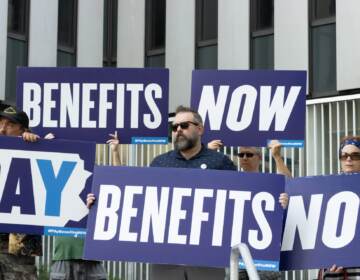Confusion, frustration for freelancers and gig workers seeking unemployment in Pa.
A federal program expanded unemployment benefits to workers who are usually ineligible, such as temps, freelancers and the self-employed, including gig workers.

Close up of 'unemployment' dictionary entry (photo via bigstock)
Are you on the front lines of the coronavirus? Help us report on the pandemic.
On Monday, the Pennsylvania Department of Labor and Industry announced it had “successfully processed” around 50,000 claims for Pandemic Unemployment Assistance (PUA), a federal program which expands jobless benefits to workers who are usually ineligible, such as temps, freelancers and the self-employed, including gig workers.
While the launch makes progress towards offering a new form of assistance, it falls short of users’ expectations and needs, leaving some frustrated. For starters, the state is not ready to actually give out the funds, and errors in the application and technological glitches have locked out eligible applicants.
One common problem? If a worker has also received a W-2 tax form, the state portal will tell them to apply for traditional unemployment compensation even if they don’t qualify.
“I’ve just been really holding out for this and thinking, ‘Ok, this is something that’s made for people like me,’” said Katrina Atkin, a yoga instructor and adjunct professor at Temple University who has has received both a W-2 and 1099 forms for her earned income in the last several months.
Unlike traditional unemployment compensation, this new assistance is designed to buoy independent contractors, self-employed business owners, gig workers and people without a long enough work history to qualify for other benefits. Depending on pre-job loss wages, recipients will receive between $195-$572 a week for up to 39 weeks, plus an additional $600 a week from April to July.
That money is the bridge many feel like they need to make it through the pandemic. Atkin applied for PUA over the weekend and received this message: “You are not eligible to file an unemployment insurance claim on this system.” It directed her to apply for typical unemployment, for which she doesn’t believe she qualifies.

“It’s a really big blow,” said Atkin, who said she did not know why her claim was rejected, but believed it could have been because she received a W-2 for about a quarter of her income.
Atkin’s boyfriend, a musician who had recently been deemed ineligible for traditional unemployment insurance, received the same message after applying for this benefit.
The state is aware that eligible recipients are being denied for this reason and is fixing the online portal, said Susan Dickinson, director of unemployment for the Department of Labor and Industry. It has also posted a message online, telling people to try again in a few days.
“Anyone who tried this weekend and felt like they should file a PUA claim but they weren’t allowed to… there won’t be any impact to their benefits if they file later,” said Dickinson. In the coming days, a new question will be added to the forms to ask applicants if they have previously applied for traditional benefits.
“Wait. I know it’s painful, but wait until the department announces that they’ve been able to fix the W-2 problem,” said Julia Simon-Mishel, supervising attorney of the unemployment compensation unit at Philadelphia Legal Assistance. “Do not go back and file for regular unemployment.” Her office has been compiling issues its clients encounter with the PUA process here. Others include issues uploading documents, and confusion about the language in the form.
Unlike traditional unemployment benefits, which begin when a claim is filed, PUA recipients will receive money backdated to when they first lost work.
‘Band-Aid’
Other issues that may have contributed to confusion are the fact that the state is not yet paying out PUA. While it’s accepting initial claims, the second step, in which eligible residents apply for money on a weekly or biweekly basis has not been launched.
Shonda Wood, of Yeadon, is a realtor and contract worker in the home health industry who lost work in late February. She used the federal stimulus check she received last week to pay her mortgage, but has been waiting for more regular relief for her lost wages. She applied for traditional unemployment compensation, but has not received money through that process, so this weekend she applied for PUA.
“That entire system is very confusing,” she said. Over the weekend, she applied at 3 a.m. during a bout of sleeplessness. “The site kept crashing on me,” she said.
In the end, she said she is not sure if she qualified.
Sole proprietor Justicia DeClue, who runs Maha Yoga in Philadelphia, said she did qualify. Now, she said she’s just waiting for money. She applied for small business relief from both the federal and city government, but has not received money from either.
DeClue did receive $7,000 through the federal Economic Injury Disaster Loan Program, because she had some staff who were not independent contractors. But she’s still struggling with fixed expenses. Like many, she has resorted to holding class online to try to make up a fraction of her lost revenue.
“It’s a Band-Aid. And the Band-Aid can hold for a little while, but if things don’t shift, it feels like we might bleed out,” she said.
WHYY is your source for fact-based, in-depth journalism and information. As a nonprofit organization, we rely on financial support from readers like you. Please give today.





![CoronavirusPandemic_1024x512[1]](https://whyy.org/wp-content/uploads/2020/03/CoronavirusPandemic_1024x5121-300x150.jpg)


